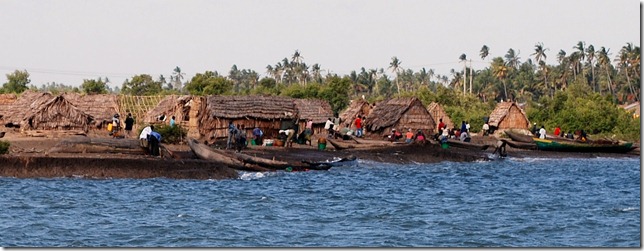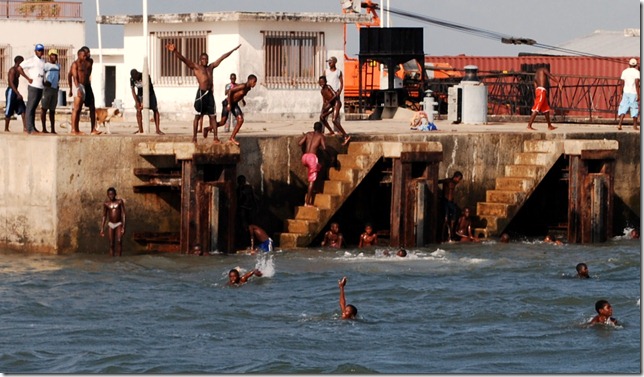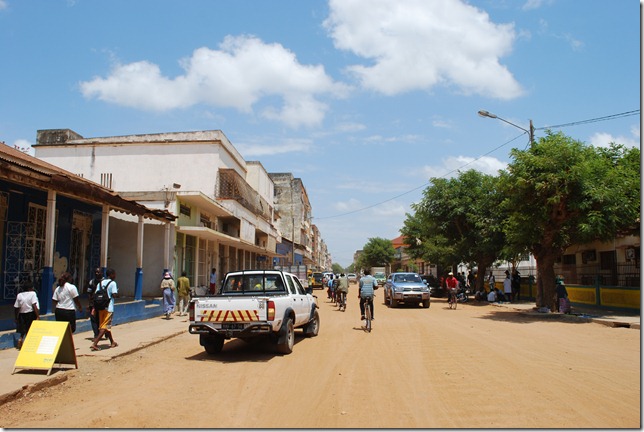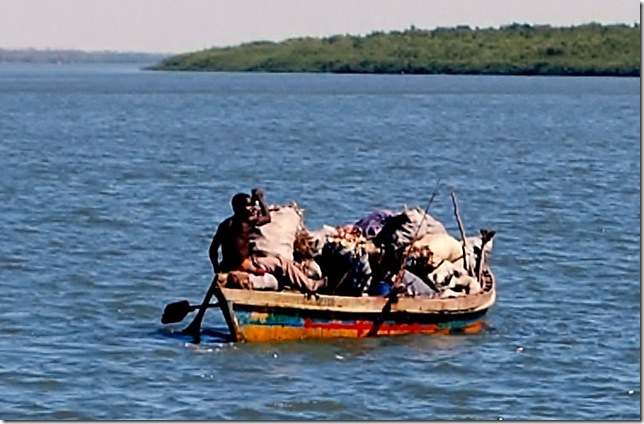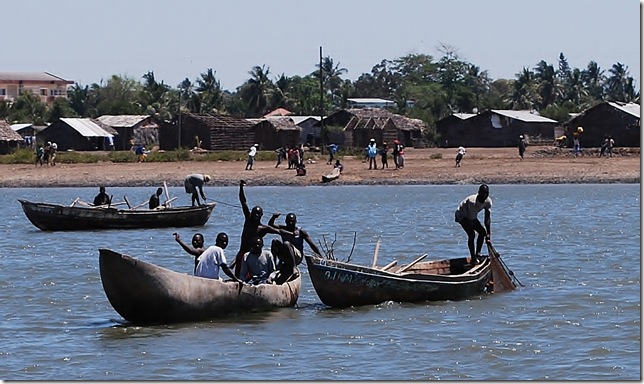Lat: 20 25.402′ S
Long: 36 00.475′ E
Quelimane certainly was an experience, and looking back, it seems to be one of those times on the trip (like when I started the bottom job in N.Z.) that we got by with a little help from our friends. Although we spent most of our time on the boat, each time we ventured out into the city (usually accompanied by Garth), we felt more comfortable with our surroundings and the language and a little more savvy. And as usual, the negatives (e.g., getting charged 50% more the second day I went to buy bread from the street vendor) were easier to swallow with a spoonful of humor.
We motored back out of the river around 4 p.m., and most of the fisherman had returned to their villages with the day’s catch. We could see hundreds of people milling about the villages attending to their afternoon chores. Meanwhile at least 50 children were by the water’s edge taking turns jumping off of the wharf. We threw a couple of soccer balls in their direction, which seemed to be a big hit.
After a very windy night at anchor at the mouth of the river, we weighed anchor around 6:00 the next morning in very calm winds. We motored out of the partially marked channel with care as the channel itself is only 10-20′ deep and surrounded on both sides by sand bars and breaking waves. By nightfall the wind had picked up and from the ESE, and it carried us southward through the night. Today it has moved farther south, but at the moment we are sailing close-hauled at 7 knots in calm seas with the main and jib. Not too shabby! So far we (or more accurately, Dallas) have been able to find opportune weather windows for getting farther south, thereby avoiding the southerly busters that are known to produce large, steep seas here in the Mozambique Channel. We should be able to ride this one out for 2-3 more days which will get us to Inhambane or even Maputo, the capital of Mozambique. Once in Maputo we will be able to breathe a little easier knowing that we are out of the cyclone zone, and we’ll be only a hop-skip-and-jump from Richard’s Bay, South Africa! There is a game park near there that looks quite interesting…
Lat: 18 02.000′ S
Lon: 36 57.900′ E
There’s a supermercado in downtown Quelimane. High-wattage signs from the desk of a graphic designer overhang the sidewalk at 20′ intervals — meats, vegetables, fruits. Along both sides of the large corner ground-floor store are larger than large plate glass windows — each one must be more than 15′ wide and 6′ tall. Nearly half of them are still there. Why? They’re too large for one man to remove and carry to sell on the sidewalk (this morning’s offering to passers-by on the sidewalk across from the bakery was a chipped 8’x4′ plate glass window). Or maybe the sealant that holds them to their frames is as modern as the defunct signs and refuses to let them loose without shattering. At any rate, it was at least 10 years ago when the supermarket shut down.
It’s been a while since it’s rained in Quelimane, but the hollow concrete interior of the supermercado adjoining the rust colored dusty street is damp, in places dripping wet with what can only be the leakage from neglected plumbing. There’s a faint odor from the place that suggests it’s been a home for the homeless. It’s two blocks off of the riverfront of a city of more than 200,000 and not more than a 3 minute bicycle taxi ride from the regional governor’s mansion, which, not coincidentally is surrounded by a large open space and the barracks for what is essentially his bodyguard corps.
In the US there’s something called a paneer, which is a sort of small, narrow shelf that you can attach to a bicycle. It has one attachment under the seat and another somewhere near the rear hub that lets you put a small basket or, if you’re ambitious, something as large as an infant behind you as you ride. In Quelimane, this is the local taxi. The paneer is padded and small rods extend from the rear hub for the passenger’s feet. The going price is no more than 30 met (less than a dollar) for anything within the downtown area.
I’m carrying our provisions in my backpack and in plastic bags dangling from each hand as my young and fit “cabbie” exhales forcefully, moving us slowly over the dirt, pavement, and dust-filled potholes that are downtown Quelimane. At one intersection, a truck claims the right of way (might makes right) and the brakes are applied. I instantly understand why there are makeshift but adept bicycle repair shops on the sidewalks and in the markets. We never come to a stop, but I can’t help but laugh at the sound. “Death of a machine” sounds on American TV and movies are nothing compared to this, but a bit of careful balance and it’s behind us. My Spanish makes for very mediocre Portuguese, but combined with backseat driver hand gestures it’s enough to get us to the dock.
Although we’ve only made a couple of brief forays into the safe downtown area, there’s more here than we can fit into a blog. Yesterday we decided that a braai (South African for BBQ) was in order. After taking us to one of the local markets where we stocked up on veggies, found me a new pair of slops (SA for flip-flops), and picked up a chic “Obama” webbing-style belt for Lauren, Garth led us to “little Maputo” (don’t come here after dark). It’s the first time I’ve seen a house made of small tree branches and mud equipped with a digital electricity meter. Never-paid-for oil from Garth’s family’s boat was still evident in the home-made mortar used in the “house” that we visited for “prawns”. The shrimp at the top of the box were about 12″ long. Roughly 20 plus of these shrimp were frozen and stacked in a box that we paid a whopping $15 for (per the madam of the house, the recent lack of rain has exerted atypical upward pressure upon estuary prawn prices).
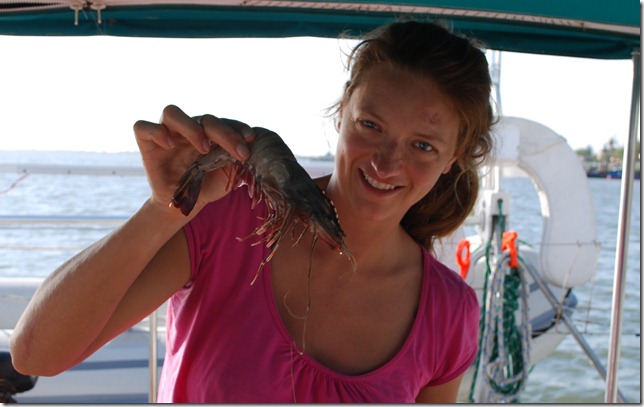 Quelimane, where all the shrimp are above average
Quelimane, where all the shrimp are above average
Back at the dock Gavin and Garth treated us to an SA-style shrimp and chicken braai that according to Lauren will go down as one of the best meals she’s ever experienced (being a vegetarian does have its drawbacks).
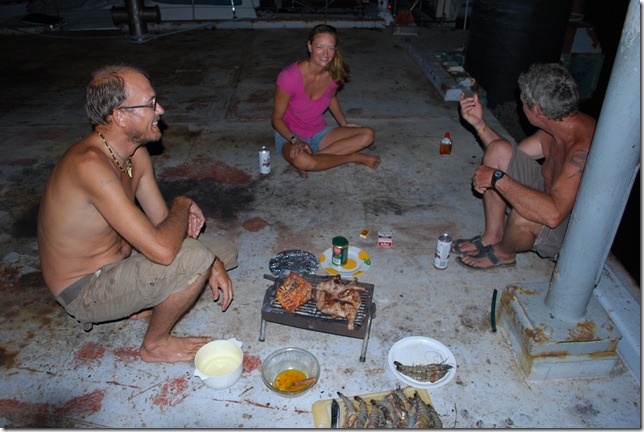 High-brow braai on the dock at Quelimane with Garth & Gavin
High-brow braai on the dock at Quelimane with Garth & Gavin
After filling our water tanks and shoving off with the outgoing tide, we’re now anchored at the mouth of the “River of Two Good Signs” waiting to sail south in the morning. The blinding almost full moon above us and the strong warm wind make the nearby beach we can just make out seem like something from a tropical paradise. A steady white light on the eastern horizon keeps getting brighter and is most likely either one of the 2-3 Maputan-owned fishing vessels that occasionally docks at the modern-but-deteriorating Japanese-donated fishing dock we just left or one of the no more than 2-3 ships per month that visits the port of Quelimane, which is being dredged daily by a dredging vessel that was most likely donated or subsidized by the West and then “privatized” at a good ‘ole boy rate to a government official’s relative whose company now has a lucrative dredging contract for the bustling port of Quelimane.
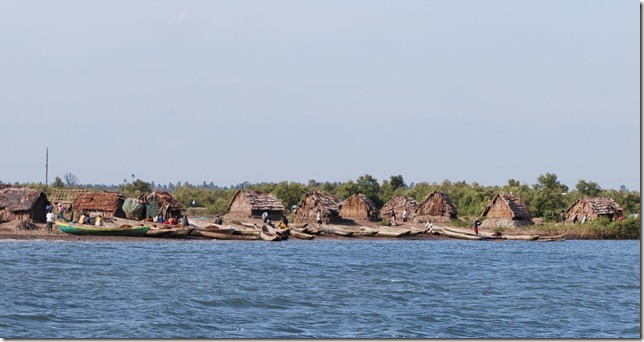 Typical riverfront fishing village with thatched huts and dugout canoes
Typical riverfront fishing village with thatched huts and dugout canoes
We’ve seen street vendors that are more respectful than their Asian (Bali) counterparts, surprisingly honest officials, a conniving and devilishly endearing boat boy, kid’s yelling F-you to us from river-front fields next to thatched-rood huts, unabashedly “racist” whitey’s, international aid workers staring and nodding with the “you’re from my world” look, and tons of people proudly wearing American T-shirts. As Gavin aptly told us, “You’re having an experience.”
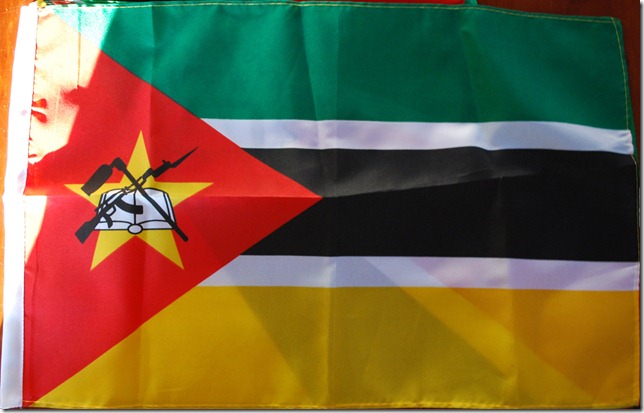 The Mozambique flag is one of the world’s unique ones – star, an AK-47, a hoe, and a Bible
The Mozambique flag is one of the world’s unique ones – star, an AK-47, a hoe, and a Bible
Well, we’re definitely “having an experience” here in Quelimane, which is well off the beaten path for cruising boats. We used the internet connection at our anchorage to Google “Quelimane crime”. Using the Google translator to translate turn the Portuguese pages into English, we learned that the locals have been suffering from a rash of machete crimes and that the police are of little assistance (we later learned that they only work until 4 or 5pm, after which, they’re not available). We decided to keep a night watch to avoid any theft or incidents, and the night passed without any problems. About 5am the next morning, a ship moored by the small container port steamed by and yelled at us to move. We were planning to head toward a floating fishing boat dock anyway, but not quite so early. Oh well. It turned out the ship was dredging a turning basin for container port ships and we were in the way. When we tied up at the dock, we were met by a couple of South Africans, Gavin and Garth, who gave us a hand getting tied up and filled us in on the local situation, which is quite different than anything we’ve seen before. The dock is a more secure place for us to spend the nights, but we don’t get an internet signal anymore and the dredging vessel flies by at full throttle sending a large wake our way that rocks the boat around quite a bit, giving the fenders a little more than they can handle at times.
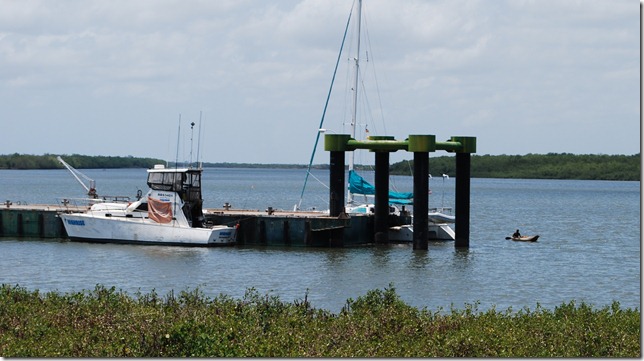 S/V Pura Vida and the South African M/V Highrise at the nice but seldom-used fishing dock
S/V Pura Vida and the South African M/V Highrise at the nice but seldom-used fishing dock
Luckily for us, Garth speaks a good bit of Portuguese and was also familiar with the local formalities. Gavin and Garth are here aboard a motor boat that had been purchased in South Africa for the family business in Tanzania. In addition to being good blokes, they’ve been fun company and extremely helpful. Unfortunately, they had numerous engine problems and have been stuck here for quite a while. The local port captain has been suspended (apparently for requiring employees to stop stealing money, come in to work on time, etc.), but the representative from the port authority showed up in the morning not too long after we finished tieing up. As he was boarding the boat, Gavin motioned silently but vigorously from the other side dock not to hand over any money. Silvestre didn’t seem to know what papers I should give him (I gave him the typical set of papers) or what exactly to tell me, though I think it was due more to language difficulty than to incompetence or figuring out how to ask for a bribe. When he came back, he asked Garth to come over and translate and things went quite smoothly. Apparently we needed a cruising permit, which costs about $64, but we needed to go to the port office to pay. It seemed a bit high to me, but it was less than Garth had paid in Maputo and he did show us an official receipt from another boat for that amount.
We needed local currency, so off we went to a money changing office and then to immigration. Immigration is really important here because of large fines that they can impose, but it’s also a bit confusing. The crew from large ships are often given renewable 30-day embarkation cards instead of regular visas. Yachts sometimes get one and sometimes the other, with the embarkation cards apparently being a source of problems (fines, bribes, etc.) on some occasions and no problem on others. Our first trip to the various offices found nobody home except customs, but one of the customs officers made a phone call and told us that customs and immigration would visit us at the dock in 40 minutes. They did show up in a reasonable amount of time and immigration stamped our passports for free (Garth had to pay about $14 each). Customs officials usually have a clear list of questions for yachts (quantity of guns, alcohol, tobacco, medicines and drugs, etc.). Sometimes radios and tenders/outboards are on the list. Here we were just asked what was on the boat. We responded with clothes, food, 2 computers, a radio, 2 bicycles, etc. not wanted to get too involved or mention things that could be a problem. The officer duly filled out our customs form indicating the presence of one Dell, one Acer, and 2 bicycles. Apparently yachts aren’t all that common here.
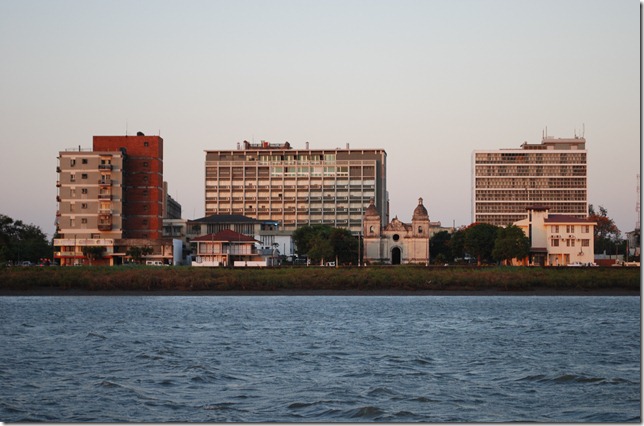 Quelimane waterfront, including neglected Portuguese colonial cathedral
Quelimane waterfront, including neglected Portuguese colonial cathedral
Silvestre, the port guy finally showed up while we were having lunch with Gavin and Garth at a local restaurant across from the dock. He had a receipt book to fill out for us as well as our clearance papers. I was happy to see the clearance papers because getting them can often involve a bribe and we need to leave in a few days anyway. Unfortunately, we needed to go to his office to pay and to have the new boss sign the papers. We’d already been waiting a good while for lunch, but Garth told us that the wait for the food would be close to 2 hours, so he and I followed Silvestre and a friend back to the office. On the way I chatted with Silvestre and found my Spanish worked reasonably well with him. We were able to talk for a while with both of us understanding most of what we were trying to say. The boss wasn’t back at the office, and after waiting while Silvestre tried to locate him, we were told that he wouldn’t be available today, but that we could pay and Silvestre would bring the papers to the boat tomorrow. My instinct was to get the papers before paying but Garth has a bit more local experience, and his thoughts were that the price was good and I should pay before more charges were identified, so I handed over the cash and off we walked back to the restaurant. Of course the food still wasn’t there, but it came before too long and we ended up with nice lunches and couple rounds of beers for four people coming to about $22. The whole time we were at the restaurant, teenage guys kept walking up to us and trying to sell us stuff. The goods ranged from sunglasses displayed using a large piece of cardboard to a TV universal remote, clothes hangers, pants, a carved wood mortar and pestle, and various other random items. My favorite was school textbooks. There is a textbook intended to teach Portuguese-speaking children English that is useful as an English-Portuguese dictionary and textbook. On the streets, the brand new textbooks, which are likely donated internationally and intended to be used in the schools, are sold to English-speaking visitors. I paid about $4 for ours (apparently 3x the local rate) thinking it might be useful when we stop in Brazil.
The stories of life here and the obvious realities that you see on the streets and in the countryside are so different than anything that occurs in the US that it would be hard to begin to understand without having seen the things we have along the way and doing a bit of reading about Africa. There’s plenty of theft – Goth’s boat had 500 liters of diesel, laptops, chartplotter, sat phone, etc. stolen when a local “friend” they’d known for a while took them out eating and drinking while others came and stole stuff. The police were no help. An angry, threatening tirade succeeded in getting the sat phone returned the next day, but so much for the rest of the stuff. There’s no shortage of examples of industrial equipment, infrastructure, and buildings that have wasted away to due lack of capital and expertise. A fully functioning old Russian fishing trawler was being used as a ferry when it developed a serious engine problem. Unable to buy or manufacture spares and unable to afford to replace the engine, the boat is now a rusting, unrecoverable chunk of steel sitting on the shore along the river. Even with a large population here (200,000 to 400,000 depending on the source), the waterfront downtown area feels like a town of fewer than 50,000. There’s only a small developed area on the waterfront and numerous large, uninhabited buildings are in a dilapidated state due to lack of care. The port authority has a large, well-fitted out machine shop full of equipment that’s never used. Long semi trailers loaded with big bags of rice are unloaded at the port by men carrying one heavy bag at a time. The river acts as the “sewage treatment plant” (the tide is the treatment/flush), the incinerator for the local hospital’s biohazard items, and a source of fish and shrimp. The river rats in the mangrove-lined banks at the city’s edge are the size of small dogs (more than 16” long). There are plenty of stories about government income and development aid that has either been diverted (stolen) by the government officials in charge or used on complex western-style equipment that is unusable in fairly short order due to lack of spare parts or ability to carry out proper maintenance. The computers at the port office are fairly new Dells that sit unpowered while paperwork is still carried out by hand with carbon copies, stamps, notebooks, and filing cabinets. The paved downtown streets are in bad need of repair and many aren’t paved at all. Everybody eventually gets caught up in the “might makes right” struggles in one way or another, making day-to-day life for everyone a struggle to obtain or hold on to resources. Privileged people, both black and white worry about theft, banditry, robbery, etc. and poor people worry about a source of income or living without one. Having a population where 50% of the people earn less than 50 dollars a month means that many people don’t have a regular paycheck-earning job like most Americans do. Here, people outside or at the fringes of the monetized economy are living side-by-side and even among those with a job, car, and nice clothes. Like other African countries, Mozambique borders were determined fairly arbitrarily by Europeans in Europe during the 19th century when there was a lack of knowledge about even the internal geography of Africa, let alone a concern for tribal differences and territories. Mozambique’s numerous tribes fight among each other for control of the government (and its resources, tax income, foreign aid, etc.). Since 1994 they’ve had a “democracy”, but the government essentially only sets up polling stations in the cities, where their supporters live, leaving the rural populations disenfranchised. Some of the locals here are friendly, but in general it’s been the least friendly place we’ve visited. That said, this is supposed to be one of the more quaint, “European”, and interesting places in Mozambique, so we’re hoping to get out a bit more and poke around. Our Africa info to date has been limited to our own very limited observations and white English-speaking locals and authors, so we’re also anxious to get to South Africa where our language barrier with the locals isn’t such an issue.
Even though we were both up by 5am, all we accomplished was a partial check-in and a good lunch out. By the time we finished lunch it was nearly 4pm and after staying up most of the previous night, Lauren and I were ready for a nap. We crashed, intending to get up in a few hours, but when I woke up at midnight I realized that sunrise was less than 5 hours away and we just slept on through the night.
It has been a pretty eventful couple of days as far as days at sea go. We found the mighty, southerly Mozambique current, and it added 2-3 knots to our speed for two days straight. Couple that with Friday’s 20 knot winds from the stern, and you have the fastest day ever for Pura Vida – over 200 miles. For several hours of my watch, our speed over ground (SOG = sailing speed + current) was consistently 11-12 knots!
With southerly winds expected on Sunday, we had originally planned to sail to a little uninhabited island called Casurina to wait for a weather window to continue to head south, but the burst of speed allowed us to continue on to Quelimane where we just dropped the anchor. This is an actual city with well-stocked stores and markets, restaurants, a couple of clubs, a public swimming pool, and as it turns out, Internet. Oh yeah.
The city is set 18 miles inland along a river. On our way into the river mouth, we began to see the dugout canoes gathering around the mouth of the river. Dallas was a little unnerved by this – it felt really strange to be bringing a cruising catamaran into such an impoverished area that we knew very little about. But the fishermen just waved and watched us pass, and a few motioned to their bellies to suggest that they wanted food. This was when I got my first pangs of white-privilege-guilt. I’m sure they won’t be the last while here in Mozambique, but that’s OK with me. I think it’s a good thing to experience and a big reason why I wanted to come here. Especially in the midst of the global economic recession, it’s good to put things into perspective. Most folks here live on less than $1/day in shanties amidst malaria-infested mosquitoes swirling around in the searing summer heat. According to stats just received from Wes, the average life expectancy for Mozambique is 47!
After seeing the undeveloped villages along the river, it was bizarre to arrive in Quelimane-proper and see a couple of high-rise buildings and other remnants of the Portuguese colonial days. According to our cruising guide, the Portuguese held the coast of Mozambique for over 200 years with just a few soldiers and traders who used the natives for free labor. The natives formed independence movements, began an armed revolt in 1964, and became independent 10 years later, but when the whites left, so did the skilled labor and equipment, and the subsequent socialist economy left people even more impoverished. If that wasn’t enough, a resistance movement funded by Rhodesia (now Zimbabwe) and South Africa started a 20-year civil war. From the cruising guide: “All useful buildings or services were destroyed, and anyone deemed skilled were hunted down and shot.” It’s a depressing history to say the least, but since the first democratic elections in 1994, life in Mozambique has become more civil with many signs of development. Nevertheless, it’s very Third World, so you can imagine my surprise when I turned on my computer to write a blog and discovered that we could get wireless internet from the boat! That will be nice to have, as it looks like we may be here several days before a window opens up to move south to the Bazaruto archipelago.


